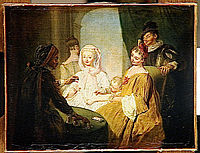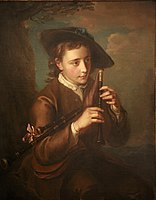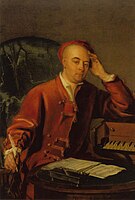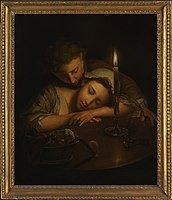Philippe Mercier
Philippe Mercier | |
|---|---|
 John Faber the Younger, Philip Mercier, 1735, mezzotint after Mercier's untraced self-portrait, National Gallery of Art, Washington, D.C. | |
| Born | 1689 |
| Died | July 18, 1760 (aged 70–71) |
| Education | Antoine Pesne |
| Known for | Painting and etching |
| Movement | Rococo |
| Patron(s) | Frederick, Prince of Wales |
Philippe Mercier (also spelled Philip Mercier; 1689 – 18 July 1760) was an artist of French Huguenot descent from the German realm of Brandenburg-Prussia (later Kingdom of Prussia), usually defined to French school.[1] Active in England for most of his working life, Mercier is considered one of the first practitioners of the Rococo style, and is credited with influencing a new generation of 18th-century English artists.[2]
Life
[edit]Mercier was born c. 1689–1691 in Berlin, the son of Pierre Mercier (died 1729, Dresden), a Huguenot tapestry-worker.[3] He studied painting at the Akademie der Wissenschaften of Berlin[4] and later under Antoine Pesne, who had arrived in Berlin in 1710. Later, he travelled in Italy and France before arriving in London—"recommended by the Court at Hannover"—probably in 1716. He married in London in 1719 and lived in Leicester Fields.
He was appointed principal painter and librarian to the Prince and Princess of Wales at their independent establishment in Leicester Fields, and while he was in favour he painted various portraits of royalty, and no doubt many of the nobility and gentry. Of the royal portraits, those of the Prince of Wales and of his three sisters, painted in 1728, were all engraved in mezzotint by John Simon, and that of the three elder children of the Prince of Wales by John Faber the Younger in 1744. This last (entitled Playing Soldiers[5]) was a typical piece of Mercier's composition, the children being made the subject of a spirited, if somewhat childish, allegory in their game of play. Prince George is represented with a firelock on his shoulder, teaching a dog his drill, while his little brother and sister are equally occupied in a scene that is aptly used to point a patriotic moral embodied in some verses subjoined to the plate, of which the concluding couplet is as follows:
Illustrious Isle where either sex displays
Such early omens of their future praise!
Faber also engraved six plates of "Rural Life" after Mercier, and several other subjects of his have survived him.
In 1733, Mercier painted a Portrait of 'Frederick, Prince of Wales, playing a violoncello, and his Sisters'. National Portrait Gallery, London. There is an alternative version of the painting in the Royal Collection. In the painting 'The Sense of Hearing', 1744, women are playing violin, violoncello, harpsichord, and flute. Yale Collection for British Art.
Mercier became involved[when?] in a scandal of some sort[clarification needed] and he lost favour. He left London around 1740 and settled in York, where he practised portrait painting for over ten years, before returning to London in 1751. In 1752, Mercier went to Portugal at the request of several English merchants. He did not long remain there, however, but came back to London, where he died in 1760.
In August 2016, Mercier's painting Portrait of a Lady (1744) was one of the subjects for episode 19 in the 5th series of the BBC Television series Fake or Fortune?[6]
Mercier's daughter Charlotte was also an artist in her early life, before turning to a life of dissolution and dying in the St James Workhouse two years after her father's death.[7]
Gallery
[edit]-
Frederick, Prince of Wales, and His Sisters, 1733, National Portrait Gallery, London
-
Bagpipe Player, 1740, Musée des Beaux-Arts de Strasbourg
-
The Italian Comedians, ca. 1735–1740, Cincinnati Art Museum
-
A Girl Holding a Cat, ca. 1750, National Galleries of Scotland, Edinburgh
-
Girl with a Tray, late 1740s, Hermitage Museum, Saint Petersburg
-
Comedians by a Fountain, ca. 1735, Royal Collection
-
The Young Wine Taster, c. 1725–1730, Louvre, Paris
-
George Frideric Handel, ca. 1730, Handel House Museum, London
-
A Music Party, ca. 1735–1740, Tate Britain, London
-
Lovers by Candlelight, ca. 1740s, private collection
References
[edit]- ^ Bataille 1930, p. 409, Bénézit 2006, p. 340, Ingamells 1996, p. 147, and Hopkinson 2016, p. 136, define Mercier as a painter of French school.
- ^ Waterhouse 1952, p. 127: "Never a first-rate artist, he had a flair for novelty in the French manner, and he seems not only to have been responsible for the introduction of the French genre style into English painting, but to have played a considerable part in popularising the 'conversation piece'"; Eidelberg 2013: "Philippe Mercier (c. 1689-1760) looms large in the history of English eighteenth-century art. One of the first practitioners of the new rococo style, Mercier’s genre subjects and portraits provided the foundation for William Hogarth and the next generation of English artists."
- ^ Vertue 1934, p. 37: "Mr. P. Merciere. painter Born at Berlin, of French extraction." Walpole 1879, p. 703, give the painter's age at his death as seventy-one. From Walpole's account, Ingamells & Raines 1976–1978, pp. 1, 8 n. 1, and Ingamells 1996, p. 147, suggest that Mercier was the Pierre-Phillipe Mercier born in 1689 to Pierre Mercier in Berlin; however, it is noted that a Phillipe Mercier, also the son of a Huguenot tapestry-worker in Berlin, was born in 1691.
- ^ Academy Webpage Archived 29 April 2009 at the Wayback Machine
- ^ "Playing Soldier". Detroit Institute of Arts. 2015. Archived from the original on 22 December 2015. Retrieved 10 September 2015.
- ^ "Fake or Fortune?, Series 5: 4. Portraits". Retrieved 22 August 2016.
- ^ Profile of Claude Mercier in the Dictionary of Pastellists Before 1800.
Further reading
[edit]- Primary sources
- Vertue, George (1932). "The Note-Books of George Vertue Relating to Artists and Collections in England (II)". The Walpole Society. 20. whole issue. JSTOR i40086519.
- Vertue, George (1934). "The Note-Books of George Vertue Relating to Artists and Collections in England (III)". The Walpole Society. 22. whole issue. JSTOR i40086509.
- Vertue, George (1936). "The Note-Books of George Vertue Relating to Artists and Collections in England (IV)". The Walpole Society. 24. whole issue. JSTOR i40086511.
- Walpole, Horace (1879). Anecdotes Of Painting In England. London: Ward, Lock, and Co. pp. 234, 346–347. OCLC 1039484687 – via the Internet Archive.
- General studies
- Eidelberg, Martin (May 1969). "Watteau's 'La Boudeuse'". The Burlington Magazine. 111 (794): 275–278. JSTOR 875934.
- Eidelberg, Martin (September 1975). "Watteau Paintings in England in the Early Eighteenth Century". The Burlington Magazine. 117 (870): 576–583. JSTOR 878129.
- Eidelberg, Martin (Winter 2006). "Philippe Mercier as a Draftsman". Master Drawings. 44 (4): 411–449. JSTOR 20444473.
- Eidelberg, Martin (24 October 2013). "Philippe Mercier, Watteau's English Follower". Watteau and His Circle. Archived from the original on 6 December 2020. Retrieved 29 April 2020.
- Harrison, Brett (Winter 2019–2020). "Philip Mercier (1691–1760) and Queen Caroline". The British Art Journal. 20 (3): 34–41. ISSN 1467-2006. JSTOR 48617250.
- Ingamells, John & Raines, Robert (1976–1978). "A Catalogue of the Paintings, Drawings and Etchings of Philip Mercier". The Walpole Society. XLVI: 1–70. JSTOR 41829356.
- Raines, Robert (1967). "Philip Mercier, A Little-known Eighteenth-century Painter". Proceedings of the Huguenot Society of London. 21: 124–137.
- Wescher, Paul (Autumn 1951). "Philippe Mercier and the French Artists in London". Art Quarterly. 14: 179–194 – via the Internet Archive.
- Exhibition catalogues
- Einberg, Elizabeth & Egerton, Judy (1988). The Age of Hogarth: British Painters Born 1675–1709 (exhibition catalogue). Vol. II. London: Tate Gallery Collections. ISBN 094659080X.
- Einberg, Elizabeth (1987). Manners & Morals: Hogarth and British Painting 1700-1760 (exhibition catalogue). London: Tate Gallery. pp. 14, 64–65, 91–92, 113, 123, 245; cat. nos. 40, 69. ISBN 0-946590-84-2. LCCN 88204213. OCLC 1150291569 – via the Internet Archive.
- Ingamells, John & Raines, Robert (1969). Philip Mercier (exhibition catalogue). York, London: York City Art Gallery, Kenwood House.
- Additional notes
- Antal, Frederick (1962). Hogarth and His Place in European Art. New York: Basic Books. OCLC 1035595582 – via the Internet Archive.
- Davies, Randall (1907). English society of the eighteenth century in contemporary art. London: Seeley. p. 37 – via the Internet Archive.
- Waterhouse, Ellis K. (1952). "English Painting and France in the Eighteenth Century". Journal of the Warburg and Courtauld Institutes. 15 (3–4): 122–135. doi:10.2307/750471. JSTOR 750471. S2CID 192246064.
- Waterhouse, Ellis K. (1978) [1953]. Painting in Britain, 1530 to 1790. The Pelican History of Art (4th ed.). Harmondsworth, England; New York: Penguin Books. ISBN 0-14-056101-3. LCCN 77019107. OCLC 1245624144 – via the Internet Archive.
- Reference books
- Bataille, Marie Louise (1930). "Mercier, Philippe". In Vollmer, Hans (ed.). Allgemeines Lexikon der bildenden Künstler von der Antike bis zur Gegenwart (in German). Vol. 24. Leipzig: E. A. Seemann. p. 409. OCLC 889110716.
- Bénézit, Emmanuel (2006) [first published in French in 1911–1923]. Benezit Dictionary of Artists. Vol. 9. Paris: Gründ. pp. 788–789. ISBN 2-7000-3079-6 – via the Internet Archive.
- Constans, Claire (1979). "Mercier (Philippe)". In Laclotte, Michel (ed.). Petit Larousse de la Peinture. Vol. 2. Paris: Larousse. p. 1181. ISBN 2-03-020149-9.
- Cust, Lionel Henry (1894). . In Lee, Sidney (ed.). Dictionary of National Biography. Vol. 37. London: Smith, Elder & Co. p. 269.
- Hopkinson, Martin (2016). "Mercier, Philippe (Philip, irrtümlich Pierre)". In Beyer, Andreas; Savoy, Bénédicte & Tegethoff, Wolf (eds.). Allgemeines Künstlerlexikon. Vol. 89. Berlin, Boston: De Gruyter. pp. 136–137. ISBN 978-3-11-023255-4. OCLC 933756744.
- Ingamells, John (1996). "Mercier, Philip". In Turner, Jane (ed.). The Dictionary of Art. Vol. 21. New York: Grove's Dictionaries. pp. 147–149. ISBN 1-884446-00-0 – via the Internet Archive.
- Ingamells, John (2004). "Mercier, Philip". In Matthew, H. C. G. & Harrison, Brian (eds.). Oxford Dictionary of National Biography. Vol. 37. Oxford, New York: Oxford University Press. pp. 856–857. ISBN 0198613873. OCLC 1035757202 – via the Internet Archive.
- Portalis, Roger; Béraldi, Henri (1882). "Mercier (Pierre)". Les graveurs du dix-huitième siècle [Engravers of the Eighteenth Century] (in French). Vol. 3 (pt. 1). Paris: D. Morgand et C. Fatout. p. 82. OCLC 1050261298 – via the Internet Archive.
External links
[edit]- 59 artworks by or after Philippe Mercier at the Art UK site
- Portraits by Philip Mercier at the National Portrait Gallery, London
- Paintings by Philip Mercier at Tate Britain
- Works by Mercier from Art.com
- Works by Mercier from Invaluable.com
- John Ingamells archive











